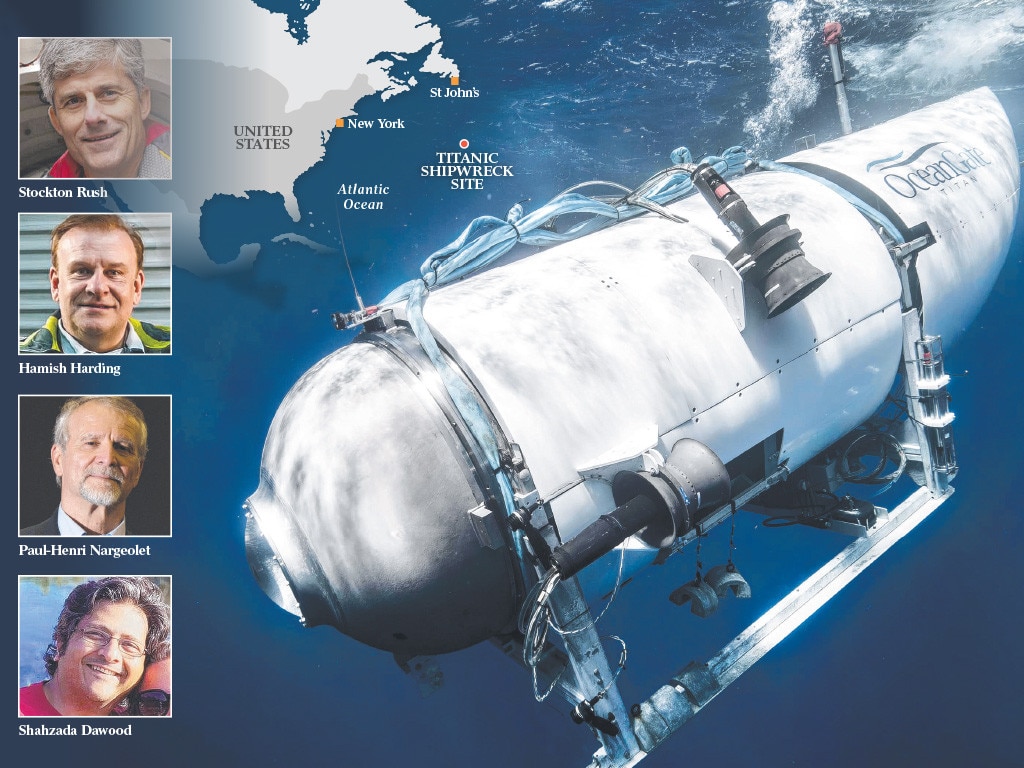Titanic submarine missing: everything we know about OceanGate Expeditions tourist sub
Here is everything we know about the voyage to the Titanic’s resting place, the sub’s safety and the chilling warning from its pilot about extreme depth exploration.

Just one hour and 45 minutes after departing its mother ship on an eight hour return dive to the wreck of the Titanic, a submersible craft operated by the exploration company OceanGate lost contact with its mother ship.
Now, with less than 40 hours left before the sub runs out of air, the US Coastguard is in a desperate race to find it. This is what we know about the submarine, its passengers and its owners.
Where is the Titanic wreck located and when was it found?

The Titanic is located around 595km off the coast of Newfoundland, Canada, at a depth of around 3km, or 12,500 feet.
To reach the wreck, adventurers must endure a two-day voyage over the cold and treacherous waters of the North Atlantic, followed by an eight hour dive, which includes a two hour descent and two hour ascent.
After sinking in April 1912, the Titanic lay undisturbed until 1985 when it was discovered by a joint French – American expedition led by Jean-Louis Michel of IFREMER and Robert Ballard of the Woods Hole Oceanographic Institution. The bow was still relatively intact, but the stern was totally destroyed.
It was mapped for the first time in 2012, with sonar imaging from underwater robots showing where hundreds of objects landed after the ship struck an iceberg and sank.
Where could the missing people be located?

The Titan submersible lost contact with its mother ship Polar Prince one hour and 45 minutes after it launched on Sunday morning local time. The search is being carried out in a remote area of the Atlantic 1448km east of Cape Cod, and up to a depth of 13000 feet, which makes it extremely challenging.
Currently there are 2 C-130 US coast guard air craft deployed for aerial surveillance as well as a Canadians C-130 and a P8 aircraft, which has been dropping sonar listening devices on the ocean.
The US Coastguard will have mapped the area from the craft’s launch from the Polar Prince to the site of the Titanic, taking into account winds and ocean currents in and surrounding that water column. However, with each hour that passes the search area will have to grow as the craft has almost certainly drifted from the zone where it originally lost contact. It could have returned to the surface and be drifting, or might still be in the water column of its route to the Titanic.
How far down is the missing tourist submarine?

The submarine could be as deep as 13000 feet. This particular craft, named Titan, is the only one of OceanGate’s three submersibles that is capable of sustaining the atmospheric pressure at this depth. The deep ocean is a hostile environment similar to outer space, with intense atmospheric pressure. At this depth, there are 380 atmospheres of pressure, or 5585 pounds per square inch, which is 380 times the pressure we feel on the surface of the earth. It is also extremely cold: around 2-3 degrees Celcius.
The Titan, 21 foot long and the size of a small truck, is made of carbon fibre and titanium but is incredibly heavy at more than 10,000kg.
According to OceanGate’s website, the Titan’s system constantly analyses the effects of changing pressure on the vessel as it dives deeper, so it can accurately assess the integrity of the structure. “This onboard health analysis monitoring system provides early warning detection for the pilot with enough time to arrest the descent and safely return to surface,” the company states.
What can survive that deep?
The zone at this depth of ocean is called the Abyssal zone, and is characterised as a near freezing area with no sunlight. It is the fourth deepest and darkest area of the ocean with little in the way of life. Sea spiders, anglerfish, and colossal squid are found here, along with chemosynthetic bacteria, tubeworms, and small fish.bIt is also home to the rare dumbo octopus, the deepest living genus of the octopus family.
What is OceanGate Inc?

OceanGate is a privately owned ocean exploration company founded in 2009 to provide crewed submersible services for researchers and explorers to access the deep ocean. It was founded by Stockton Rush, a businessman with links to the aerospace industries, who is also the company’s CEO. Mr Rush, who said his dream had always been to aid ocean exploration, has been named as one of the passengers on the missing craft.
OceanGate began taking tours to the Titanic three years ago. It says on its website that it has successfully completed over 14 expeditions – for scientific research, filming and tourism – and over 200 dives in the Pacific, Atlantic and Gulf of Mexico.
It has three submersible craft – the Titan, Cyclops 1 and the Antipodes.
How safe is the Titan?

The marine director at OceanGate Expeditions was fired after raising warnings over serious flaws in the craft in 2018, while scientists in the oceanographic exploration community have claimed they “always knew” disaster would strike the submersible, while explorers and thrill seekers have spoken out about their experience of malfunctions in the vessel.
David Lochridge was given 10 minutes to clear his desk after delivering a report outlining his fears over safety concerns to CEO Stock Rushton.
Those concerns included Mr Lochridge’s worry that “visible flaws” in the carbon fibre supplied to OceanGate raised the risk of small flaws expanding into larger tears during “pressure cycling.”
He was also worried over the lack of non-destructive testing performed on the Titan’s hull but was told the company would rely on “acoustic monitoring” to detect damage. Mr Lochridge pointed out this type of acoustic analysis would only show when a component was about to fail — often milliseconds before an implosion, according to court papers filed in 2018.
The filing also claims that hazardous flammable materials were being used within the submersible.
A top oceanographer told Sky News UK this week the deep sea exploration community “knew this was going to happen at some point”, but “nothing was done about it”.
Dr David Gallo, Director of Special Projects at the Woods Hole Oceanographic Institution told Sky: “Anyone in the exploration business of the deep sea expected this to happen, not at this particular time, but we knew this was going to happen at some point.”
What are conditions like on the tourist submarine?

The 21 foot long Titan carries up to five people in cramped, basic conditions. Passengers seated behind the pilot can’t easily move around the cabin but the craft has huge “view ports” through which they can observe the ocean as far as the light extends. There are also high definition cameras that capture the ocean life as they pass it.
Although the vessel is diving through freezing, high pressure ocean, inside the craft the temperature is warm and passengers need wear only their usual clothes, with no need for specialised clothing.
The craft has 96 hours of air: this means that there is possibly now less than 70 hours of air left.
How many people are on the Titan?
Five people are on the Titan, including OceanGate CEO Stockton Rush, who founded the company in 2009. British billionaire and explorer Hamish Harding has been confirmed to be on the missing sub.

His stepson Brian Szasz posted on Facebook a family photo with “thoughts and prayers for my family”.
Also named as one of the missing is French pilot Paul Henry Nargeolet, Director of Underwater Research Program at Premier Exhibitions, RMS Titanic Inc. In a previous interview Mr Nargeolet spoke of the dangers of extreme depth exploration.
“If you are 11 metres or 11 kilometres if something bad happens, the result is the same,” he said. “When you’re in very deep water, you’re dead before you realise that something is happening, so it’s just not a problem.”
The other passengers are British based millionnaire Shahzada Dawood, 48, and his son, 19-year-old Suleman.
Who is the billionaire on board?

Hamish Harding is a British billionaire and explorer, the founder of Action Group and chairman of Action Aviation, an international aircraft brokerage based in Dubai.
On Saturday Mr Harding posted on social media that he was due to join the expedition to the Titanic alongside “a couple of legendary explorers, some of which have done over 30 dives to the RMS Titanic since the 1980s”. He said the dive would be attempted on Sunday at 4am after leaving St John’s, Newfoundland on Saturday.
RMS TITANIC EXPEDITION
— Hamish Harding (@ActionAviation0) June 17, 2023
I am proud to finally announce that I joined @OceanGateExped for their RMS TITANIC Mission as a mission specialist on the sub going down to the Titanic.@ExplorersClub@actionaviation@One_More_Orbit#PolarPrince
Full story at:https://t.co/7UWUrKGyTQ
Mr Harding warned this particular trip was likely to be the first and only manned mission to the Titanic this year because of harsh weather conditions.
“Due to the worst winter in Newfoundland in 40 years, this mission is likely to be the first and only manned mission to the Titanic in 2023,” he wrote in a Facebook post on Saturday night local time. He added: “A weather window has just opened up and we are going to attempt a dive tomorrow.
“We started steaming from St John’s, Newfoundland, Canada yesterday and are planning to start dive operations around 4am tomorrow morning. Until then, we have a lot of preparations and briefings to do.”
Mr Harding holds the Guinness record for the fastest circumnavigation of the Earth via the North and South Poles by an aircraft – 46 hours, 40 minutes and 22 seconds.
What happened to the missing passengers of the Titanic?

Many of the 1500 victims of the Titanic are still on the ocean floor. Photographs taken in 2004 for an expedition by the National Oceanic and Atmosphere Administrationdo indicate signs of human remains at the site, according to the NOAA director of maritime heritage, James Delgado.
Sonar mapping carried out in 2012 by RMS Titanic Inc, the legal custodian of the wreck also shows a huge debris field where hundreds of objects and pieces of the Titanic landed after striking an iceberg.
The scanning also showed the immense damage done to the ship, indicating the stern had rotated like a helicopter’s blades, and the deckhouse had ended up as a ruined tangle.
What other deep water submarine tours operate?
Blue Marble Private, a bespoke travel company operating out of London, takes up to nine ocean tourists at a time on a five hour journey to the Titanic, for upwards of $137,000 per person.
Blue Fish Excursions charge around $59,680 for a 13-day excursion to the site of the Titanic that includes a dive of up to around 12 hours.








To join the conversation, please log in. Don't have an account? Register
Join the conversation, you are commenting as Logout